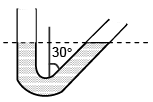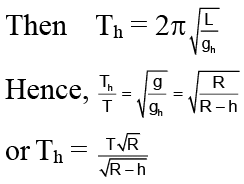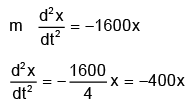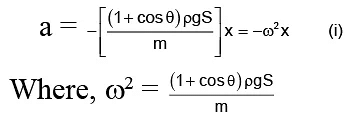Integer Answer Type Questions for JEE: Simple Harmonic Motion (Oscillation) | Chapter-wise Tests for JEE Main & Advanced PDF Download
Q.1. Show that the period of oscillation of simple pendulum at depth h below earth’s surface is inversely proportional to where R is the radius of earth. Find out the time period of a second pendulum at a depth R/2 from the earth’s surface?
where R is the radius of earth. Find out the time period of a second pendulum at a depth R/2 from the earth’s surface?
Ans. 2.8
At earth’s surface the value of time period is given by
Where, L is the effective length of the simple pendulum and g is the acceleration due to gravity and is equal toAt depth h if the period is Th and acceleration due to gravity is gh,
Thus, Th is inversely proportional to
Time period at h = R/2 is given by
Q.2. A particle of mass 4 gm. lies in a potential field given by V = 200x2 + 150 ergs/gm. Deduce the frequency of vibration.
Ans. 3.2
The potential energy of the 4gm mass U = mV = 4 (200x2 + 150) = 800x2 + 600 ergs
The force F acting on the particle is given by= - 1600x
Then the equation of motion of the particle is given by
Hence, frequency of oscillation
Q.3. The equation of a simple harmonic motion is given by x = 6 sin10 t + 8 cos10 t, where x is in cm, and t is in seconds. Find the resultant amplitude.
Ans. 10
x = 6 sin 10 t + 8 cos 10 t
= 10 sin (10 t + ϕ) where ϕ = tan-1 (8/6)
∴ Resultant amplitude = 10 cm.
Q.4. A cubical body (side 0.1 m and mass 0.02 kg) floats in water. It is pressed and then released so that it oscillates vertically. Find the time period of oscillation. (Density of water = 103 kg/m3).
Ans. 0.0885
When a floating cubical body is displaced down through a small distance x, the excess buoyant force that is known as the restoring force is given as
F = -vρg
Where v = volume of the excess liquid displaced = Ax
⇒ F = -Aρgx; A = area of cross section of the cube.
m = 0.02 kg, ρ = 103 kg/m3, A = (0.1)2 m2 .
T == 0.0885 sec
Q.5. Find the time period of the motion of a particle shown in figure. Neglect the small effect of the bend near the bottom.
Ans. 0.726
The time of motion for one cycle = 2 [tAB + tBC]
where tAB =
AB = h cosec θ and BC = h cosec β.
H = 0.10 m , θ = 45°, β = 60°
T = 0.726 sec.
Q.6. Determine the period of oscillation of mercury of mass m = 200g poured into a bent tube whose right arm forms an angle q = 30° with the vertical. The crosssectional area of the tube S = 0.50 cm2. The viscosity of mercury is to be neglected.
Ans. 0.8
The difference of level in the two tubes is given by
= x + xcosθ = x (1+cosθ)
The change in pressure ΔP is given by
ΔP = x (1+cosθ) ρg
Force F = ma = - [x (1+cosθ) ρg]S
Equation (i) is the equation of S.H.M. It’s time period T is given by
Substituting the given values, we get
T = 2 x 3.14= 0.8 sec.
Q.7. The length of a sonometer wire between its fixed ends is 110 cm. Where two bridges should be placed in between the ends so as to divide the wire into 3 segments whose fundamental frequencies are in the ratio 1: 2: 3?
Ans. 20, 30, 60
If L1, L2, L3 be the lengths of the three segments then
L1 + L2 + L3 = 100If n1, n2 and n3 be the fundamental frequencies of the three segments then
f1 = f
f2 = 2f
f3 = 3f,
Since, f1: f2: f3 = 1: 2: 3
The tension remains the same throughout the wire. Hence
f1L1 = f1L2 = f3L3
or, fL1 = 2fL2 = 3fL3
or, L1 = 2L2 = 3L3
If L3 = x, L2 = 3/2x, L1 = 3x
∴ L1 + L2 + L3 = 3x + 3/2 x + x = 110 cmor, 11x = 220 cm
L3 = x = 20 cm
L2 = 3/2 x = 30 cm
L1 = 3x = 60 cm
The bridges should be placed in the positions of 54.54 cm from the zero end and 18.18 cm from the other end.
|
446 docs|930 tests
|



























